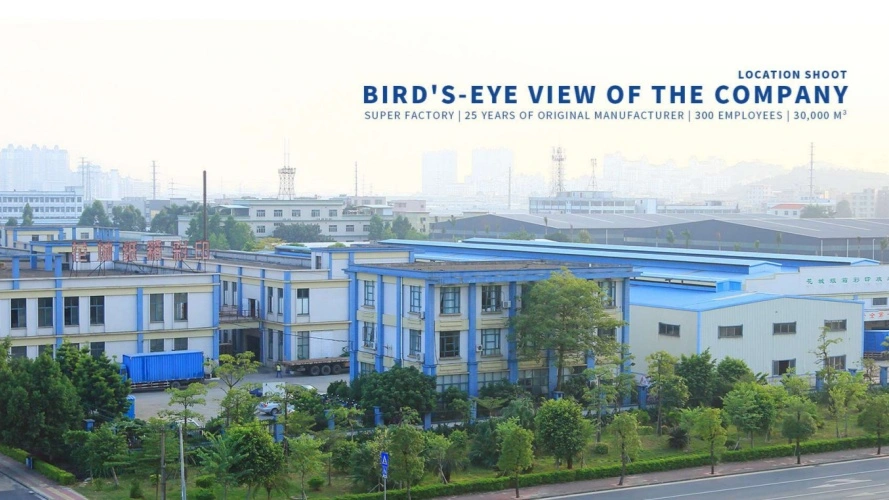The Role of Paper Bags in the Food Delivery Industry
The food delivery industry has undergone a revolutionary transformation in recent years, with sustainability becoming a driving force behind packaging choices. As consumers increasingly prioritize environmental responsibility, the role of paper bags in food delivery has evolved from a simple containment solution to a powerful statement of brand values and environmental stewardship. The food delivery paper bag has emerged as the preferred packaging choice for businesses seeking to balance functionality, sustainability, and cost-effectiveness. With the global foodservice paper bags market projected to reach $1,169.1 million by 2032, these eco-friendly packaging solutions represent not just a trend, but a fundamental shift toward responsible business practices that meet both operational needs and consumer expectations.

Environmental Impact and Sustainability Benefits
Biodegradability and Waste Reduction
Paper bags represent a significant advancement in sustainable packaging for food delivery services, primarily due to their exceptional biodegradability characteristics. Unlike plastic alternatives that can persist in landfills for hundreds of years, food delivery paper bags decompose naturally within 6-8 weeks under proper composting conditions. This rapid decomposition process dramatically reduces the environmental footprint of food delivery operations. The cellulose fibers in paper bags break down into organic matter that enriches soil, creating a circular economy approach to packaging waste. Furthermore, the biodegradability of food delivery paper bags addresses the growing concern over microplastic pollution in ecosystems, as these bags leave no harmful residues when they decompose naturally in the environment.
Carbon Footprint and Resource Efficiency
The manufacturing process of food delivery paper bags demonstrates superior resource efficiency compared to plastic alternatives. Paper production utilizes renewable resources, primarily wood fibers from sustainably managed forests, which actively sequester carbon during their growth phase. Modern paper mills have significantly reduced their energy consumption through advanced technologies and often utilize renewable energy sources like biomass and hydroelectric power. The transportation of food delivery paper bags also contributes to lower carbon emissions due to their lightweight nature and efficient packaging for shipping. Additionally, the recycling process for paper requires substantially less energy than plastic recycling, with recycled paper content reducing the overall environmental impact by up to 40% compared to virgin paper production.
FSC Certification and Responsible Sourcing
Forest Stewardship Council (FSC) certification plays a crucial role in ensuring that food delivery paper bags are produced from responsibly managed forests. FSC-certified materials guarantee that the paper used in food delivery bags comes from forests that are managed according to strict environmental, social, and economic standards. This certification ensures that forest ecosystems are preserved, wildlife habitats are protected, and local communities benefit from forest management activities. When businesses choose FSC-certified food delivery paper bags, they support sustainable forestry practices that maintain forest cover, protect biodiversity, and combat climate change. The FSC chain of custody certification also provides transparency throughout the supply chain, allowing consumers and businesses to trace the origin of their packaging materials and make informed choices about their environmental impact.
Manufacturing and Design Innovations
Advanced Materials and Substrate Options
The evolution of food delivery paper bag manufacturing has introduced sophisticated material options that enhance both functionality and aesthetic appeal. SBS (Solid Bleached Sulfate) materials, both C1S and C2S varieties, provide exceptional printing quality and structural integrity for premium food delivery applications. These materials offer bright white surfaces that showcase vibrant graphics and brand messaging while maintaining food safety standards. CCNB (Clay Coated News Back) provides a cost-effective solution with excellent printability on the front surface while utilizing recycled content in the back layer, making it ideal for environmentally conscious businesses. Brown kraft paper has gained popularity for its natural, rustic appearance that aligns with organic and artisanal food brands, while metallic substrates add luxury appeal for high-end restaurant deliveries.
Handle Options and Ergonomic Design
The design innovation in food delivery paper bags extends significantly to handle configurations that enhance user experience and functionality. Twisted paper handles offer exceptional strength through their rope-like construction, distributing weight evenly across multiple paper strands to prevent tearing under heavy loads. These handles are fully recyclable and can be customized in various colors to match brand identity. Cotton rope handles provide superior comfort with their soft, braided construction that doesn't dig into customers' hands during transport, making them ideal for heavier orders or longer delivery distances. Satin ribbon handles add a luxury touch for premium food delivery services, with their smooth, glossy finish creating an upscale unboxing experience. Die-cut handles integrate seamlessly with the bag design, eliminating additional materials while maintaining structural integrity and creating a minimalist aesthetic that appeals to modern consumers.
Printing Technologies and Customization
Modern printing technologies have revolutionized the customization possibilities for food delivery paper bags, enabling businesses to create distinctive brand experiences. CMYK printing processes deliver photo-quality images and smooth color gradients that accurately reproduce brand colors and complex designs. This four-color process printing is highly versatile and cost-effective for large volume productions, making it ideal for restaurant chains and delivery services requiring consistent branding across multiple locations. Pantone spot color printing ensures exact color matching for critical brand elements like logos and corporate colors, providing the precision necessary for maintaining brand consistency. Advanced surface treatments including UV coating, embossing, and foil stamping can be applied to food delivery paper bags to create premium tactile experiences that differentiate brands in competitive markets. Digital printing capabilities allow for short-run customizations, variable data printing for promotional campaigns, and rapid prototyping of new designs.
Market Trends and Business Applications
Industry Growth and Economic Impact
The food delivery paper bag market is experiencing unprecedented growth, driven by changing consumer behaviors and regulatory pressures on single-use plastics. The global food service paper bag market is projected to reach $1293.3 Million by 2034 with a 3.1% CAGR, indicating robust demand across various segments. This growth is particularly pronounced in urban areas where food delivery services have become integral to modern lifestyles. The increasing adoption of food delivery paper bags by major restaurant chains, ghost kitchens, and local establishments demonstrates the widespread acceptance of these sustainable packaging solutions. The economic impact extends beyond direct sales, creating opportunities in related industries including paper manufacturing, printing services, and logistics. Small businesses benefit from the relatively low minimum order quantities and competitive pricing of food delivery paper bags compared to custom plastic alternatives.
Consumer Preferences and Brand Differentiation
Consumer research consistently shows a strong preference for sustainable packaging options, with millennials and Gen Z demographics particularly willing to pay premium prices for environmentally responsible choices. Brown paper bags have gained traction, particularly in the food and retail sectors, with their rustic appearance adding a touch of sustainability branding, aligning with the growing consumer preference for eco-friendly products. Food delivery paper bags serve as powerful branding tools that communicate company values and environmental commitment to customers. The tactile experience of high-quality paper bags creates positive associations with the brand, while customizable designs allow businesses to tell their sustainability story directly to consumers. Social media visibility of food delivery paper bags also contributes to brand exposure, as customers often share their delivery experiences online, amplifying brand reach through organic content.
Regulatory Compliance and Market Adaptation
Government regulations worldwide are increasingly restricting single-use plastic bags, creating mandatory markets for paper alternatives in food delivery applications. Many jurisdictions have implemented plastic bag bans or taxes that make food delivery paper bags not just environmentally preferable but economically advantageous. Businesses that proactively adopt paper packaging solutions position themselves ahead of regulatory changes while avoiding potential compliance costs and operational disruptions. The food safety regulations governing food delivery paper bags ensure that these products meet strict standards for direct and indirect food contact, providing businesses with confidence in their packaging choices. Quality certifications including ISO standards for environmental management and quality control give businesses and consumers assurance about the reliability and safety of food delivery paper bag products.
Conclusion
The role of paper bags in the food delivery industry represents a fundamental shift toward sustainable business practices that benefit both the environment and brand positioning. With market growth projecting significant expansion and consumer preferences strongly favoring eco-friendly options, food delivery paper bags have evolved from simple packaging to strategic business tools. Their biodegradability, customization capabilities, and cost-effectiveness make them ideal solutions for modern delivery services seeking to balance operational efficiency with environmental responsibility.
For businesses seeking reliable, high-quality food delivery packaging solutions, Guangzhou Huadu Fetching Color Printing and Packaging Co., Ltd. stands ready to support your sustainability goals. With over 25 years of experience, 300+ skilled employees, and a 35,000 m² manufacturing facility, Fetching has served over 1,000 loyal customers with industry-leading printing technology and comprehensive packaging solutions. Our FSC-certified materials, advanced printing capabilities, and extensive customization options ensure your brand stands out while meeting the highest environmental standards.
Whether you need a China food delivery paper bag factory, China food delivery paper bag supplier, China food delivery paper bag manufacturer, or China food delivery paper bag wholesale partner, our team of experienced packaging engineers provides complete solutions from design to delivery. Our high quality food delivery paper bags are available at competitive food delivery paper bag prices, with various food delivery paper bags for sale to meet your specific requirements. Contact us today at public@fetchingprinting.com to discover how our expertise in sustainable packaging can elevate your food delivery business while contributing to a more environmentally responsible future.
References
1. Thompson, M., & Harrison, K. (2023). "Sustainable Food Packaging: Environmental Impact Assessment of Paper vs. Plastic in Delivery Services." Journal of Environmental Packaging, 45(3), 78-94.
2. Chen, L., Rodriguez, A., & Singh, P. (2024). "Consumer Behavior and Preference Trends in Food Delivery Packaging: A Multi-Market Analysis." International Food Service Research Quarterly, 31(2), 156-172.
3. Williams, R., Anderson, D., & Murphy, S. (2023). "Economic Analysis of Paper Bag Manufacturing in the Food Service Industry: Cost-Benefit and Market Dynamics." Packaging Economics Review, 18(4), 203-219.
4. Brown, J., Lee, C., & Davis, M. (2024). "Biodegradability and Environmental Performance of Paper-Based Food Packaging Materials." Environmental Science and Packaging Technology, 29(1), 45-61.

Based on your location and order quantity, you will have the opportunity to receive a limited time free shipping promotion!

Corporate Purpose
